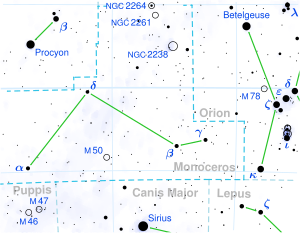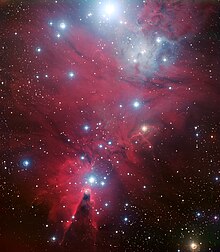 S Monocerotis lies in NGC 2264 at the very northern edge of Monoceros. | |
| Observation data Epoch J2000 Equinox J2000 | |
|---|---|
| Constellation | Monoceros |
| A | |
| Right ascension | 06 40 58.656 |
| Declination | +09° 53′ 44.71″ |
| Apparent magnitude (V) | 4.66 (4.62 - 4.68) + 5.90 |
| B | |
| Right ascension | 06 40 58.566 |
| Declination | +09° 53′ 42.20″ |
| Apparent magnitude (V) | 7.830 |
| Characteristics | |
| Spectral type | O7V((f))zvar + O9.5Vn + B2V |
| U−B color index | −1.034 |
| B−V color index | −0.261 |
| Variable type | Ia |
| Astrometry | |
| A | |
| Radial velocity (Rv) | 22.00 km/s |
| Proper motion (μ) | RA: −2.61 mas/yr Dec.: −1.61 mas/yr |
| Parallax (π) | 3.55 ± 0.50 mas |
| Distance | 720 pc |
| Absolute magnitude (MV) | −5.21 |
| B | |
| Proper motion (μ) | RA: −1.971 mas/yr Dec.: −4.225 mas/yr |
| Parallax (π) | 1.4019 ± 0.0984 mas |
| Distance | 2,300 ± 200 ly (710 ± 50 pc) |
| C | |
| Proper motion (μ) | RA: −1.464 mas/yr Dec.: −2.746 mas/yr |
| Parallax (π) | 1.5438 ± 0.0394 mas |
| Distance | 2,110 ± 50 ly (650 ± 20 pc) |
| Orbit | |
| Primary | Aa |
| Companion | Ab |
| Period (P) | 108±12 yr |
| Semi-major axis (a) | 112.5±6 mas |
| Eccentricity (e) | 0.770+0.023 −0.030 |
| Inclination (i) | 47±2° |
| Longitude of the node (Ω) | 60±3° |
| Periastron epoch (T) | B 1996.05+0.15 −0.10 |
| Argument of periastron (ω) (secondary) | 63±4° |
| Details | |
| Aa | |
| Mass | 29.1 M☉ |
| Radius | 9.9 R☉ |
| Luminosity | 214,000 L☉ |
| Surface gravity (log g) | 4.5 cgs |
| Temperature | 38,500 K |
| Rotational velocity (v sin i) | 120 km/s |
| Ab | |
| Mass | 21.3 M☉ |
| Age | 3.1 Myr |
| Other designations | |
| 15 Monocerotis, HD 47839, HIP 31978, HR 2456, SAO 114258, BD+10°1220 | |
| Database references | |
| SIMBAD | data |
| ARICNS | data |

S Monocerotis, also known as 15 Monocerotis, is a massive multiple and variable star system located in the constellation Monoceros. It is the brightest star in the Christmas Tree open cluster in the area catalogued as NGC 2264.
S Monocerotis is found within an open cluster and the Washington Double Star Catalog lists many companion stars. The closest and brightest is S Mon B, magnitude 7.8 and 3 arcseconds away. It is classified as B2 main sequence star with a mass of 7.31 M☉. Designated component C is an 11th-magnitude B8V star. The cluster contains another dozen or so 9th and 10th magnitude stars and many fainter stars.
S Monocerotis A is a spectroscopic binary system with an eccentric orbit of about 112 years. Since 1943, the spectrum of this star has served as the MK standard for O7 by which other stars are classified. It is also an irregular variable star with a range of less than a tenth of a magnitude. The orbital parameters can be used to derive the masses of the two stars, giving 31 M☉ and 11 M☉.
The distance to S Monocerotis and NGC 2264 has been derived in various ways, including dynamical parallax and isochrone fitting. These consistently give estimates of 700 - 900 parsecs, although this is double the likely distance derived from the Hipparcos parallax measurements. Gaia Early Data Release 3 contains parallaxes for the companions components B and C of 1.4 mas and 1.5 mas respectively, consistent with the expected distance to the cluster.
References
- ^ Høg, E.; Fabricius, C.; Makarov, V. V.; Urban, S.; Corbin, T.; Wycoff, G.; Bastian, U.; Schwekendiek, P.; Wicenec, A. (2000). "The Tycho-2 catalogue of the 2.5 million brightest stars". Astronomy and Astrophysics. 355: L27. Bibcode:2000A&A...355L..27H. doi:10.1888/0333750888/2862. ISBN 0333750888.
- ^ Cvetkovc, Zorica; Vince, Istvan; Ninkovic, Slobodan (2008). "Orbit of Binary 15 Monocerotis". arXiv:0804.0698 .
- ^ Samus, N. N.; Durlevich, O. V.; et al. (2009). "VizieR Online Data Catalog: General Catalogue of Variable Stars (Samus+ 2007-2013)". VizieR On-line Data Catalog: B/GCVS. Originally Published in: 2009yCat....102025S. 1. Bibcode:2009yCat....102025S.
- Sota, A.; Maíz Apellániz, J.; Walborn, N. R.; Alfaro, E. J.; Barbá, R. H.; Morrell, N. I.; Gamen, R. C.; Arias, J. I. (2011). "The Galactic O-Star Spectroscopic Survey. I. Classification System and Bright Northern Stars in the Blue-violet at R ~ 2500". The Astrophysical Journal Supplement. 193 (2): 24. arXiv:1101.4002. Bibcode:2011ApJS..193...24S. doi:10.1088/0067-0049/193/2/24. S2CID 119248206.
- ^ Cvetković, Z.; Vince, I.; Ninković, S. (2010). "A new orbit of binary 15 Monocerotis". New Astronomy. 15 (3): 302–306. Bibcode:2010NewA...15..302C. doi:10.1016/j.newast.2009.09.002.
- ^ Tokovinin, A. A. (1997). "MSC - a catalogue of physical multiple stars". Astronomy and Astrophysics Supplement Series. 124: 75–84. Bibcode:1997A&AS..124...75T. doi:10.1051/aas:1997181.
- ^ Oja, T. (August 1985). "Photoelectric photometry of stars near the north Galactic pole. II". Astronomy and Astrophysics Supplement Series. 61: 331–339. Bibcode:1985A&AS...61..331O.
- Pourbaix, D.; Tokovinin, A. A.; Batten, A. H.; Fekel, F. C.; Hartkopf, W. I.; Levato, H.; Morrell, N. I.; Torres, G.; Udry, S. (2004). "SB9: The ninth catalogue of spectroscopic binary orbits". Astronomy and Astrophysics. 424 (2): 727–732. arXiv:astro-ph/0406573. Bibcode:2004A&A...424..727P. doi:10.1051/0004-6361:20041213. S2CID 119387088.
- ^ Van Leeuwen, F. (2007). "Validation of the new Hipparcos reduction". Astronomy and Astrophysics. 474 (2): 653–664. arXiv:0708.1752. Bibcode:2007A&A...474..653V. doi:10.1051/0004-6361:20078357. S2CID 18759600.
- Feinstein, A.; Vazquez, R. A.; Benvenuto, O. G. (1986). "Of-stars in young open clusters". Astronomy and Astrophysics. 159: 223. Bibcode:1986A&A...159..223F.
- ^ Brown, A. G. A.; et al. (Gaia collaboration) (2021). "Gaia Early Data Release 3: Summary of the contents and survey properties". Astronomy & Astrophysics. 649: A1. arXiv:2012.01533. Bibcode:2021A&A...649A...1G. doi:10.1051/0004-6361/202039657. S2CID 227254300. (Erratum: doi:10.1051/0004-6361/202039657e). Gaia EDR3 record for this source at VizieR.
- ^ Brown, A. G. A.; et al. (Gaia collaboration) (2021). "Gaia Early Data Release 3: Summary of the contents and survey properties". Astronomy & Astrophysics. 649: A1. arXiv:2012.01533. Bibcode:2021A&A...649A...1G. doi:10.1051/0004-6361/202039657. S2CID 227254300. (Erratum: doi:10.1051/0004-6361/202039657e). Gaia EDR3 record for this source at VizieR.
- ^ Maíz Apellániz, J. (2019). "Gaia DR2 distances to Collinder 419 and NGC 2264 and new astrometric orbits for HD 193 322 Aa,Ab and 15 Mon Aa,Ab". Astronomy and Astrophysics. 630: A119. arXiv:1908.02040. Bibcode:2019A&A...630A.119M. doi:10.1051/0004-6361/201935885. S2CID 247759810.
- ^ Herrero, A.; Kudritzki, R. P.; Vilchez, J. M.; Kunze, D.; Butler, K.; Haser, S. (1992). "Intrinsic parameters of galactic luminous OB stars". Astronomy and Astrophysics. 261: 209. Bibcode:1992A&A...261..209H.
- Sung, Hwankyung; Stauffer, John R.; Bessell, Michael S. (2009). "A Spitzer View of the Young Open Cluster NGC 2264". The Astronomical Journal. 138 (4): 1116–1136. arXiv:0906.3072. Bibcode:2009AJ....138.1116S. doi:10.1088/0004-6256/138/4/1116. S2CID 5272305.
- Bernacca, P. L.; Perinotto, M. (1970). "A catalogue of stellar rotational velocities". Contributi Osservatorio Astronomico di Padova in Asiago. 239 (1): 1. Bibcode:1970CoAsi.239....1B.
- Hohle, M. M.; Neuhäuser, R.; Schutz, B. F. (2010). "Masses and luminosities of O- and B-type stars and red supergiants". Astronomische Nachrichten. 331 (4): 349–360. arXiv:1003.2335. Bibcode:2010AN....331..349H. doi:10.1002/asna.200911355. S2CID 111387483.
- Worley, C. E.; Douglass, G. G. (1997). "The Washington Double Star Catalog (WDS, 1996.0)". Astronomy and Astrophysics Supplement Series. 125 (3): 523. Bibcode:1997A&AS..125..523W. doi:10.1051/aas:1997239.
- Garrison, R. F. (December 1993). "Anchor Points for the MK System of Spectral Classification". Bulletin of the American Astronomical Society. 25: 1319. Bibcode:1993AAS...183.1710G. Archived from the original on 2019-06-25. Retrieved 2012-02-04.
External links
| Constellation of Monoceros | |||||||||||||
|---|---|---|---|---|---|---|---|---|---|---|---|---|---|
| Stars |
| ||||||||||||
| |||||||||||||
| Star clusters |
| ||||||||||||
| Nebulae |
| ||||||||||||
| Galaxies |
| ||||||||||||
| NGC 2264 | |
|---|---|
| Components | |
| Stars | S Monocerotis (15 Monocerotis) |